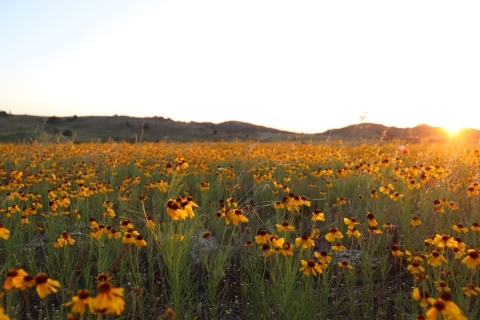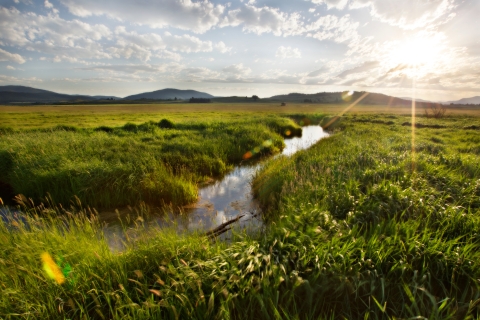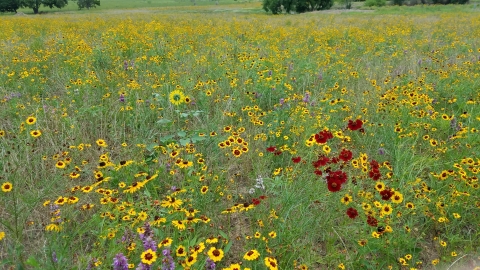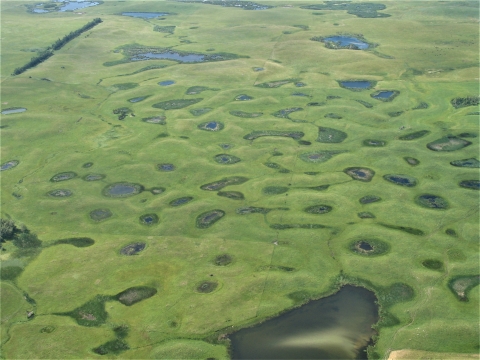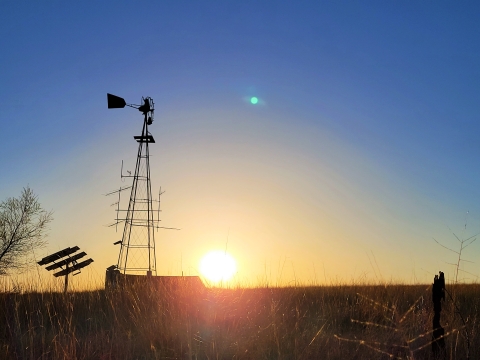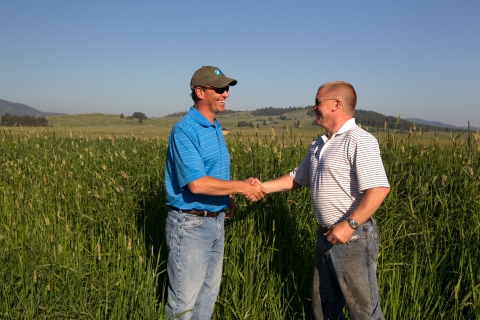Management and Conservation
We manage the Service's public grasslands to promote grassland conservation and to contribute to the overall conservation effort, and we make use of non-regulatory and incentive-based tools to focus on grassland birds, pollinators, and aquatic species. In an effort to bridge gaps between the Service and our Indigenous and Tribal partners, we work alongside the Service’s Native American Liaisons to facilitate collaborative efforts across the biome, incorporating a combination of Traditional Ecological Knowledge (TEK) and conservation practices.
The Grasslands and Sagebrush Conservation Portal is an ArcGIS Online platform that provides access to maps, apps, data, documents, and other resources for practitioners working in grassland and sagebrush sagebrush
The western United States’ sagebrush country encompasses over 175 million acres of public and private lands. The sagebrush landscape provides many benefits to our rural economies and communities, and it serves as crucial habitat for a diversity of wildlife, including the iconic greater sage-grouse and over 350 other species.
Learn more about sagebrush biomes. Many of the resources are developed by the U.S. Fish and Wildlife Service and our partners to use in planning and implementing conservation actions.
The Service partners with the Western Association of Fish and Wildlife Agencies (WAFWA), Midwestern Association of Fish and Wildlife Agencies (MAFWA), the Midwest Landscape Initiative, and Migratory Bird Joint Ventures to advance species conservation and recovery in grassland ecosystems. By developing sophisticated models, we will be better able to identify where we might realize the highest return on land conservation efforts.
In Nebraska, the Service has partnered with the Rainwater Basin Joint Venture and the National Wetlands Inventory to increase the accuracy of data used to identify woody encroachment in wetlands and wet-meadows, which will help inform efforts to remove woody cover. Many grassland-obligate bird species are not able to use encroached areas, although exact tolerance levels are not known. More information about the interactions between breeding birds and woody encroachment can help our partnership be more efficient and effective when taking actions benefit declining species.
In the Service’s Southwest Region, the Partners for Fish and Wildlife (PFW) program has used $2.6 million dollars annually for the last 20 years to assist private landowners and Tribes, resulting in more than 1,000 projects involving grassland habitat improvement conservation practices applied on approximately 750,000 acres. The PFW program works alongside landowners to implement on-the-ground restoration and conservation measures on privately-owned land. The Oaks and Prairies Joint Venture Grassland Restoration Incentive Program (GRIP) has also allocated over $3 million in incentives since 2013 to over 300 projects for over 140,000 acres.
Our Projects and Research
The Service and USGS have come together to develop a better understanding of nesting periods for grassland birds to help inform timing of management practices in the region. This project was developed in coordination with South Dakota Game, Fish and Parks and North Dakota Game and Fish Department to address shared information needs for grassland management across the region. Across the Northern Great Plains, the Migratory Birds program is working with the Northern Great Plains Joint Venture to better-understand nesting performance, depending on a range of factors, in an effort to identify the best conservation practices to slow or reverse the declines of these grassland bird species.
In Kansas, USGS and the Service came together again to fund a study that will increase our knowledge of the relationship between lesser prairie-chickens and the landscape, which will help identify the most ideal conditions for these imperiled birds throughout their range.
In the Prairie Pothole Region, the Service is working alongside USGS and the Prairie Pothole Joint Venture to evaluate nest survival for North American ducks, and how long-term system changes across the landscape - including climate change climate change
Climate change includes both global warming driven by human-induced emissions of greenhouse gases and the resulting large-scale shifts in weather patterns. Though there have been previous periods of climatic change, since the mid-20th century humans have had an unprecedented impact on Earth's climate system and caused change on a global scale.
Learn more about climate change - have affected survival rates. Information gathered from this effort will be used to evaluate, refine, and implement conservation plans for the Prairie Pothole Joint Venture.
The North Dakota Ecological Services Office and the North Dakota Natural Resources Trust are working together to help leverage the Grassland Restoration Incentives Program, a program funded by oil and gas offsets. The program pays for increased diversity in seed mix and provides incentives for landowners to remain in the program. In the first project, incentives were provided to a landowner to enter into a perpetual grassland easement to be administered by the Service, providing multiple conservation benefits through the restoration of 300 acres of cropland to native grassland.
The Missouri River Fish and Wildlife Conservation Office and the Great Plains Fish Habitat Partnership have partnered together to identify and prioritize restoration and protection areas for grassland aquatic species. This effort will help inform habitat conservation for a number of aquatic species across the grassland ecosystem.
In Kansas, Nebraska, South Dakota, and New Mexico, the Migratory Birds program has teamed up with Refuges to expand the growing network of Motus radio stations to track the migratory patterns and habitats for grassland songbirds. These stations will improve our ability to track the movement of songbirds across the region, leading to the identification of critical time periods and habitats.
In Montana, the Service is piloting an acoustic monitoring project to evaluate the response of priority grassland songbirds to ongoing conservation actions such as grassland restoration, grazing systems and other habitat enhancements.
The Partners for Fish and Wildlife (PFW) program works alongside landowners to implement on-the-ground restoration and conservation measures on privately-owned land. The PFW program provides free technical and financial assistance to landowners, managers, tribes, corporations, schools and nonprofits interested in improving wildlife habitat on their land. Projects are voluntary and customized to meet landowners’ needs. Participating landowners continue to own and manage their land while they improve conditions for wildlife.
Read about some of our work with private landowners in the grasslands:




